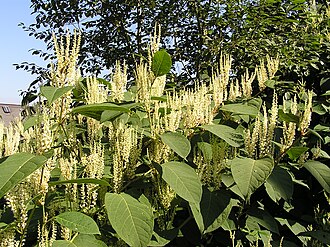Translations:AY Honors/Agriculture/Answer Key/26/en
From Pathfinder Wiki
Polygonum cuspidatum
| Polygonum cuspidatum (Japanese knotweed) | |
|---|---|
|
Where found: Japanese knotweed is native to eastern Asia in Japan, China and Korea. In the U.S.A. and Europe the species is very successful and has been classified as invasive in several countries.
Description: A member of the family Polygonaceae, Japanese knotweed has hollow stems with distinct raised nodes that give it the appearance of bamboo, though it is not related. While stems may reach a maximum height of 3–4 m each growing season, it is typical to see much smaller plants in places where they sprout through cracks in the pavement or are repeatedly cut down. The leaves are broad oval with a truncated base, 7–14 cm long and 5–12 cm broad, with an entire margin. The flowers are small, creamy white, produced in erect racemes 6–15 cm long in late summer and early autumn.
Control: The success of the species has been partially attributed to its tolerance of a very wide range of soil types, pH and salinity.[2] Its rhizomes can survive temperatures of −35 °C (−30 °F) and can extend 7 meters (23 ft) horizontally and 3 meters (9.8 ft) deep, making removal by excavation difficult. The most effective method of control is by herbicide application close to the flowering stage in late summer or autumn. In some cases it is possible to eradicate Japanese knotweed in one growing season using only herbicides.
|
 |
